Laser and waterjet cutting are two common processes manufacturers use in sheet metal fabrication. Both processes are fundamentally different, but their application in sheet metal cutting is intertwined based on the benefits manufacturers derive from using them. As a result, choosing between the water jet or laser cutting process is not as straightforward as you think.
Choosing between the two should only occur after understanding the waterjet cutting vs laser cutting comparison. Therefore, this article will help you understand both cutting processes. It introduces the water jet versus laser cutting debate regarding their similarities, applications, and other methods you could use for your materials.
Comparisons Between Waterjet Cutting vs Laser Cutting
A Brief Table Exploring Their Differences
Are you finding it hard to decide which cutting process is ideal for your project? Below is a general comparison of both cutting processes and whether they are ideal for your project.
| Waterjet cutting | Laser cutting | |
| Process | Involves cutting materials using high-speed abrasive-containing water | Involves cutting materials using a laser beam from a laser cutting machine |
| Material | Compatible with all materials | Compatible with all materials except some thermosensitive and reflective ones. |
| Wall thickness | Can cut materials with thicknesses of 0.4” to 2.0” (10 to 50 mm). | Suitable for materials with thicknesses of about 0.12” to 0.4” (3 to 10 mm) |
| Tolerances | +/-0.005″ | +/- 0.002″ |
| Cutting speed | Not more than 20” thickness per minute | About 70” thickness per minute |
The Process of Waterjet and Laser Cutting
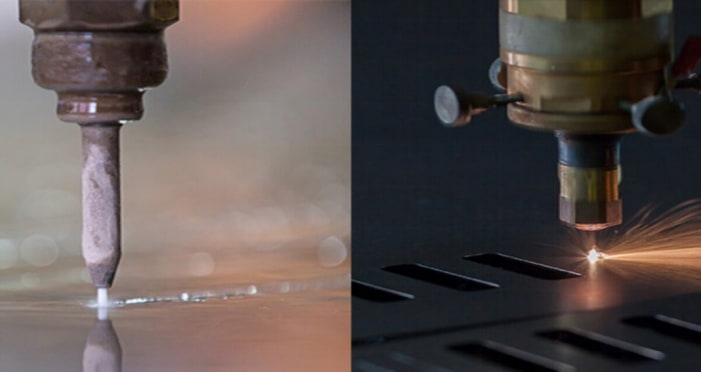
On the one hand, laser cutting involves using a laser machine that emits a laser beam to cut material. The cutting process, power, efficiency, and compatibility depend on the laser marking machine chosen. For example, fiber laser machines are strong and suitable for metals, while CO2 laser machines are suitable for non-metals.
On the other hand, the waterjet cutting process involves using a waterjet machine that produces pressurized water to cut through materials. The water contains abrasives such as aluminum oxide and garnet, which help increase the cutting ability. The waterjet machine can cut all materials due to the high concentration and speed.
Compatible Material
One of the major deciders of the better method in the waterjet cutting vs laser cutting comparison is the type of materials you can mark.
Laser cutting is suitable for a wide range of materials, with common ones being plastics, glass, wood, and metals. However, it is unsuitable for reflective materials as they can bounce off the laser beam. It is also unsuitable for extremely thermolabile materials. The materials compatible with laser cutting also depend on the machine. Therefore, your laser cutting service can advise you to choose a certain machine for your material. For example, most laser cutting enthusiasts would cut organic materials using the CO2 laser cutting machine.
Waterjet cutting has little to no restriction in terms of compatible materials. Unlike laser cutting, it does not produce heat, making it suitable for many materials. All materials can be cut with waterjet cutting.
Wall Thickness Achieved by Each Technique
Laser cutting is the cost-effective method for cutting workpieces with a thickness of about 0.12” to 0.4” (3 to 10 mm). However, the quality of the process depends on the material you are working with. For example, the maximum thickness allowable for laser cutting aluminum will be lower than carbon steel as the latter is more thermostable.
Waterjet cutting has a few limitations based on thickness as the method is generally more suitable for thicker with a thickness range of 0.4” to 2.0” (10 to 50 mm). Going lower would render the process ineffective or damage the workpiece due to the pressure of the waterjet.
Part Precision of Each Technique
Laser cutting has higher precision than waterjet cutting as its minimum cutting slit size is 0.006” (0.15 mm). The waterjet cutting has a minimum cutting slit size of 0.02” (0.5 mm). Also, laser cutting has a tolerance of approximately 0.002” (0.05 mm) while waterjet cutting has a 0.008” (0.2 mm).
Cutting Speed of Each Technique
The cutting speed in the waterjet cutting vs laser cutting debate is the thickness of material that can be cut per minute. Laser cutting has a higher cutting speed (about 70” per minute), making it more productive than waterjet cutting (not more than 20”)
Similarities Between Laser Cutting and Waterjet Cutting
Both sheet metal cutting processes look different, although there are several similarities. Below are a few similarities between laser cutting and waterjet cutting.
· Versatility
Many enthusiasts have a problem choosing one of the cutting processes because of their versatility. Both are suitable for working with many materials, including steel, stainless steel, aluminum, copper, and bronze.
· Small Kerf Width
Kerf width is the amount of material the cutting machine removes per cut. Both cutting processes have a small kerf width. The waterjet cutting has a kerf width of about 0.7mm to 1.02mm, and laser cutting has 0.08mm-1mm. Due to the small kerf width, both methods are suitable for fine detailing and intricate shape creation.
· High Quality
Both methods deliver high-quality cut parts due to the precision and accuracy of the machines involved.
Applications of Parts Made with Each Technique
Popular Laser Cutting Applications: in 5 Industries
With laser cutting, parts are made with extreme precision, accuracy, and tolerance. They also have high cost-effectiveness. Common industries where they are applicable include:
Automotive Industry
Laser cutting is used to cut automotive parts such as floor pans, hoods, roofs, and doors and engrave vehicle interiors. These parts are very strong, and they require a highly precise and accurate cutting process. Also, laser cutting is suitable as it produces less waste making it cost-effective and more suitable for the industry.
Die, Mold, and Tool Industries
Laser cutting is applicable in several ways in the die, mold, and tool industries. For example, its high degree of tolerance and ability to cut into different depths of materials makes it suitable for making die-casting molds. Also, it has a high speed (about 70” per minute), making it suitable for sturdy metals. Generally, laser cutting is applicable in these industries because of the need for a highly precise, tolerant, and accurate process.
Jewelry Industry
Laser cutting is applicable in cutting intricate designs on jewelry pieces made from gold, silver, and diamonds, and creating jewelry pieces. It is the primary cutting process due to its impeccable cutting accuracy, allowing you to work with small parts and small kerf width to minimize material wastage.
Medical Industry
Laser cutting is used in cutting parts used in making medical devices such as stents, valve framers, flexible shafts, and hones. Also, it is used in laser surgery as it allows surgeons to operate with high precision. Medical device manufacturing company prefers it due to the need for a highly accurate cutting process.
Electronic Industry
Laser cutting is used to cut electrical components such as circuit boards, cable stripping, custom electrical enclosures, and control panels. Electrical components manufacturers work with laser cutting when there is a huge requirement for high tolerance, precision, and accuracy, especially in circuit boards.
Popular Waterjet Cutting Applications: in 2 Industries
Waterjet cutting is applicable in cutting thermally unstable parts, has stringent thermal requirements, and is thick aside from the requirement for extreme precision, accuracy, and tolerance. Two popular industries where the process is used are:
Automotive Industry
Waterjet cutting is applicable in making parts such as flanges, metal gaskets, skid plates, and custom vehicle bodies. The cutting process does not lead to mechanical stress and heat-affected zones. Also, these parts have a high thickness, and a waterjet machine is more productive without reducing the quality of cuts.
Aerospace Industry
Waterjet cutting is applicable in making components of jet engines, turbine blades, cabin panels, etc. It is a suitable method as it produces no heat, which reduces microscopic cracks and warping in the parts.
Is Laser Cutting More Expensive Than Waterjet Cutting?
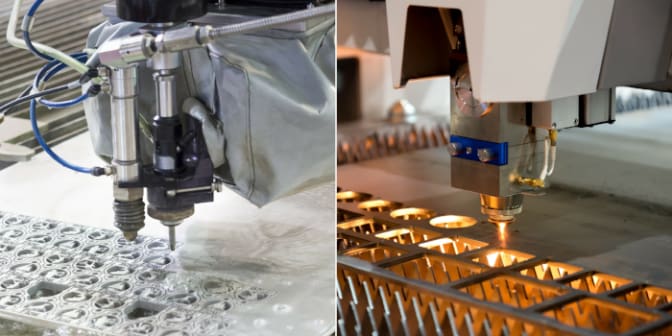
To understand the cost difference between laser and waterjet cutting, you need to know the tooling and component, operator, and machine costs. Below is the water jet vs laser cutting cost comparison.
· Tooling & Component Costs
Laser cutting does not have any tooling cost, and also, it also has a low component cost due to the high demand for the process.
Waterjet cutting has high component costs due to the consumables you need and the components needed for proper maintenance of the waterjet machine. Fortunately, a waterjet machine doesn’t require tooling.
· Operation Costs
Generally, laser cutting costs about $13-$20 per hour, while waterjet cutting has a general range of $15-$30 per hour. Although close, it might become important if you deal with a large project. The operation cost of both sheet metal cutting processes should be considered in the waterjet cutting vs laser cutting debate for those that outsource their projects.
· Machine Cost
A waterjet machine is less costly than a laser cutter. According to many enthusiasts, the most expensive part of laser cutting is purchasing the equipment. Aside from the up-front cost of purchasing the equipment, the operation cost of the laser cutting also depends on the power cost. This is an important point to note if you are not outsourcing your project to a sheet metal cutting service (although we would recommend outsourcing to one).
Which is Best for Your Applications, Laser Cutting or Waterjet Cutting?
This article does not wish to decide on the better method for the two cutting processes. Instead, it aims to aid in your decision by comparing both processes. The best cutting method of the waterjet cutting vs laser cutting comparison is the one suitable for your project. Nevertheless, you can consider several factors when deciding on a suitable method. For example, laser marking is the better method for projects requiring extreme precision and efficiency. For thick materials, waterjet cutting and thermolabile materials, waterjet cutting is better
Choosing the right cutting method for your project might be cumbersome as you have to balance several factors. Therefore, for a better operation, you can outsource to a sheet metal fabrication service such as RapidDirect. With RapidDirect, you have access to an expert team with extensive experience in waterjet cutting, laser cutting, and other sheet metal fabrication processes. Consequently, you are assured of efficiency without a loss in quality.
We are an ISO 9001:2015 certificated company with many manufacturing plants, advanced facilities, and sophisticated machines to help you achieve your project. By choosing us, you enjoy up to a 30% price reduction and a fast lead time. Upload your design file to RapidDirect online manufacturing platform and get a quote and DfM analysis within 12 hours.
Problems That Affect Part Integrity in Each Technique
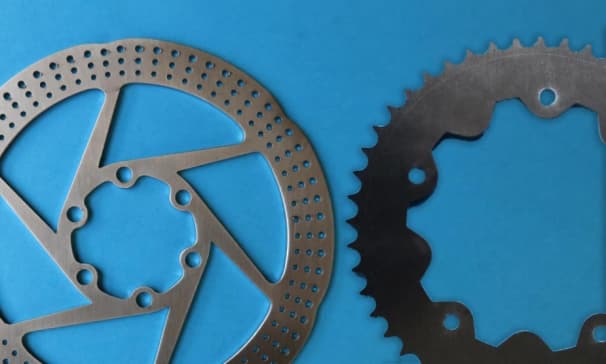
Both techniques have problems that can affect the integrity of the parts you are working with. The effect can be little or cumbersome depending on the team’s expertise in handling the project. Consequently, it is important to know the problems and look for a reputable sheet metal cutting service with extensive knowledge of both manufacturing processes. Below are several problems that can affect part integrity.
Laser Cutting: Can Lead to Burn Mark
Laser cutting can lead to burn marks on the cut side of the part during the cutting process. Sometimes, it is possible to remove the burnt part via cleaning, although sometimes it is not possible.
If it is not possible to remove the burn mark after cleaning, you have to consider it during the project preparation. For example, if you work with plywood, you can ensure the cut side will have colors that will blend with the impending burn mark. If you can’t control it, you can choose another cutting method.
Waterjet Cutting: Too Much Pressure on Small Parts
Waterjet cutting exerts high pressure on parts due to the waterjet stream blasting the workpiece at a high rate, sometimes around 60,000 PSI. For large parts, this might not be a problem. However, when working with small parts, can lead to deformation or ineffective cutting.
Alternative Ways of Cutting Metals
Based on several factors, both methods might not be suitable for cutting materials due to requirements related to productivity, efficacy, etc. When talking of metals, you might need to consider other alternatives. Two alternative ways are plasma cutting machines and turret presses.
· Plasma Cutting
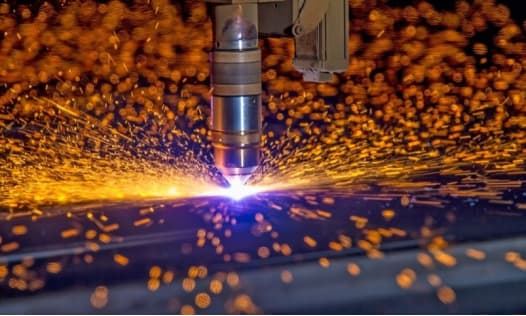
Plasma cutting involves using a jet of ionized gas at a temperature above 20,000°C to cut material. The process is suitable for selected materials and should be best reserved for steel and aluminum jobs. The cutting process is popularly known for its cost-effectiveness, precision, and cost. Plasma cutting machines have an exorbitant cost (about $300,000). However, they have a lower operating cost than water jet or laser cutting.
· Turret Press
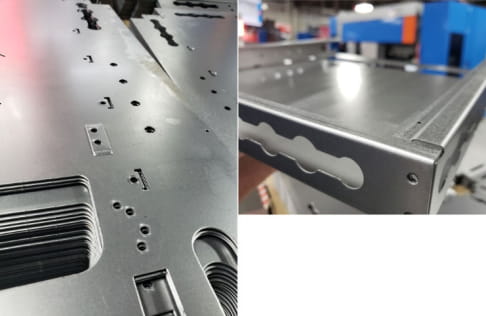
Another method for cutting metals is the turret press. A turret /punch is a type of punch press that cuts a metal part by punching through it, creating holes of different diameters depending on the chosen size. Using a turret press takes time depending on your size; however, they can be worth it if you’re consistently making the same component. This is an advantage over laser cutting
Conclusion
Choosing between the water jet or laser cutting process should only occur after understanding their comparison. To help you achieve this, this article introduced cutting processes in terms of processes, disadvantages, advantages, applications, and alternative methods. While this might give your insight into the better method, the perfect way to get the best cutting method for your project is to seek advice from professionals. Do you have a question related to water jet or laser cutting? Kindly reach out to our team of experts.
FAQs
The major advantage of waterjet cutting over other cutting methods is that it produces no heat. Consequently, it is compatible with any material and guarantees the operator’s safety. Another advantage enthusiasts consider is its suitability for cutting thick materials as the process is suitable to cut material having a thickness of 0.4” to 2.0” (10 to 50 mm).
Generally, most enthusiasts consider water jet cutting better than plasma, although it all depends on your project. Waterjet cutting is more suitable for thick materials, has higher material compatibility, and is more accurate. Also, plasma cutting will deliver fewer quality cuts as the plasma will struggle to melt the workpiece without producing unwanted slag.
A waterjet machine is more suitable for cutting thick materials than other machines and can work with 12 inches thick materials, unlike the other methods. Also, water jet cutting is compatible with all materials, while laser cutting has limitations based on thermosensitive and reflective materials, and plasma is only suitable for metals.


